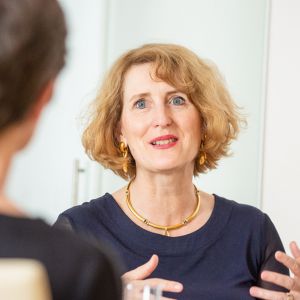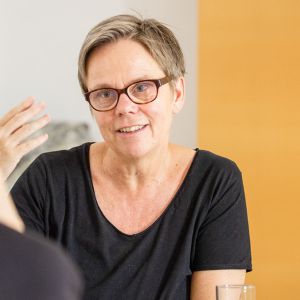After two years of intensive work, our university’s Diversity Strategy is finished. How diversity can be compatible with the idea of entrance exams, what concrete measures have now been planned, and just what good all this will do our institution are explained by Rector Ulrike Sych and Vice Rector Gerda Müller in the following interview.
Art is regarded as being international, diverse, and open to the world. So why does a University of Music and Performing Arts even need a diversity strategy to begin with?
Gerda Müller (GM): There isn’t just one art: we quite consciously speak of “musics” and “traditions”. And we train people in various fields—like research, education, and instrumental studies, to mention just three. And in the instrumental studies programme, for instance, we work with multiple different instruments and repertoires. So in order to portray just what our artistic diversity stands for, we feel that there’s a need for a diversity strategy.

Ulrike Sych (US): I’ll add to that by mentioning our students’ and teachers’ diverse cultural backgrounds along with the great heterogeneity of our study programmes. A music therapist, for example, comes from a vastly different place than does a concert pianist or an actor. And even so: all of them have a place at our university.
Art can also be something elitist, something that can be used to assert one’s distinction and superiority relative to other groups. Elite status, excellence, and diversity—how do these actually go together for you?
US: Wonderfully—it’s the perfect mix! Our understanding of quality is quite broad. We’re not satisfied with the people at our institution simply being excellent at what they do; people’s overall attitudes are also important. This institution’s commitment to upholding human rights and human dignity is non-negotiable, so those who find themselves unable to ascribe to this attitude won’t feel very good here.
GM: We’ve spent two years examining mechanisms of inclusion and exclusion at the mdw. Who comes here to study and who ends up not doing so? 70 percent of our students have at least one parent with a university-level education. By comparison: at the University of Vienna, it’s just below 50 percent. So in order to broaden access, we’re doing projects in schools with characteristics like high numbers of migrant students, and our music education students have provided refugees with music instruction. Additionally, we’re trying to make a theme of diversity and inequality in the context of excellence and elite status in training our own students.
There’s a rigorous selection process that one has to go through in order to be admitted to the mdw. How can we avoid having this bottleneck become a sort of “standardisation machine”?
US: A selection process is only ever a momentary snapshot, and even the addition of lots of supplementary criteria won’t change that.
But at the same time, I see people from around 70 different nations studying with us—and this cultural diversity makes our university strong. An example from the mdw’s research disciplines would be the Department of Ethnomusicology, whose head Ursula Hemetek was chosen to receive the Wittgenstein Award. The ethnomusicological work being done there has brought forth a new area of minority research that focusses on marginalised groups and their musics.
GM: Still, we are indeed looking to reform the admissions process itself: for one thing, we’re redoing the informational material to ensure that it’s understandable, and we’re also making it available in multiple languages. People should be able to find their way to us even if they haven’t yet had any personal contact with the university. The admissions process should run according to criteria that are transparent and comprehensible to everyone. And we also want to offer checkboxes that can be used to request alternative exam methods.
What kinds of methods are talking about, here?
GM: To give you just one example: we have blind people who are interested in studying with us. So the idea is that if a blind person registers for an entrance exam and clicks the corresponding checkbox, we’ll know to make the appropriate preparations. Like providing forms of published music that can be read by the blind. And informing the commission beforehand. People who have trouble moving around on their own, on the other hand, may need help getting to the exam location. So in general, we’re looking to set up processes that make it just as routine for people with neurological and physical limitations to take the entrance examination with us as it is for people without such limitations.
This also requires some openness on the part of the examiners…

GM: It absolutely does—which is why we also want to encourage our instructors to engage in some self-reflection: What goes on in an admissions setting? What do I need to pay attention to? Quite a while back, we did an internal study on the criteria used to evaluate performance in an artistic sense. The mdw-based sociologist Rosa Reitsamer and her team videoed recitals and discussed them with the instructors. The intention behind this was to help instructors better understand their own “mindsets” and to support them in critically questioning their ways of doing things.
Diversity is also always associated with internationality—so what role does internationality play in the mdw’s strategy?
GM: It’s always been a central factor in all of our considerations—regardless of whether we’re talking about curricula, admission, or assisting international students. Over 45 percent of our students come from abroad, and we want to provide them with even more support when they arrive in Vienna. Our idea here is a buddy system: we form tandems, with more advanced students accompanying their colleagues from abroad for the first seven months following their arrival in Vienna as they settle into everyday student life, look for apartments, and take care of the usual bureaucratic things. And it’s also about getting to know the city—things like where to go out and what clubs are good.
What other measures are you planning?
GM: The themes of gender and diversity are to be anchored in all curricula. We’ll also be putting together a set of guidelines on gender- and diversity-sensitive teaching. And as a fifth measure, we’re looking to increase the share of women among the professors. For woman researchers, there will be mentoring and financial support for things like conferences and translation services. And we’re talking with our woman artists about their careers while they’re still students.
What have you learned in the process of developing this strategy?
GM: I’ve gained a new perspective on the mdw and gotten to know so many facets of this organisation—which is absolutely priceless.
It all sounds as if the entire university were working towards the same goal. Isn’t there anyone who objects and says: “We don’t need all this”?
GM: We definitely do have people who say that. Some of them have simply denied the existence of any discrimination at the mdw. But the results of our work have shown us that it’s been worth the effort to analyse diversity from the perspective of an excellence-focussed organisation.
When you turn your eyes to the future, what do you hope will be different at this university in five, ten years thanks to the Diversity Strategy?
US: Equal treatment and diversity have got to be such a matter of course that they no longer need to be explicitly discussed. I also hope that the mdw’s example will encourage other places of artistic training to follow suit. And thinking beyond the University: diversity, transculturality, and equal treatment should be viewed as things that go without saying from a political standpoint and therefore be anchored in the programmes of all political parties.

